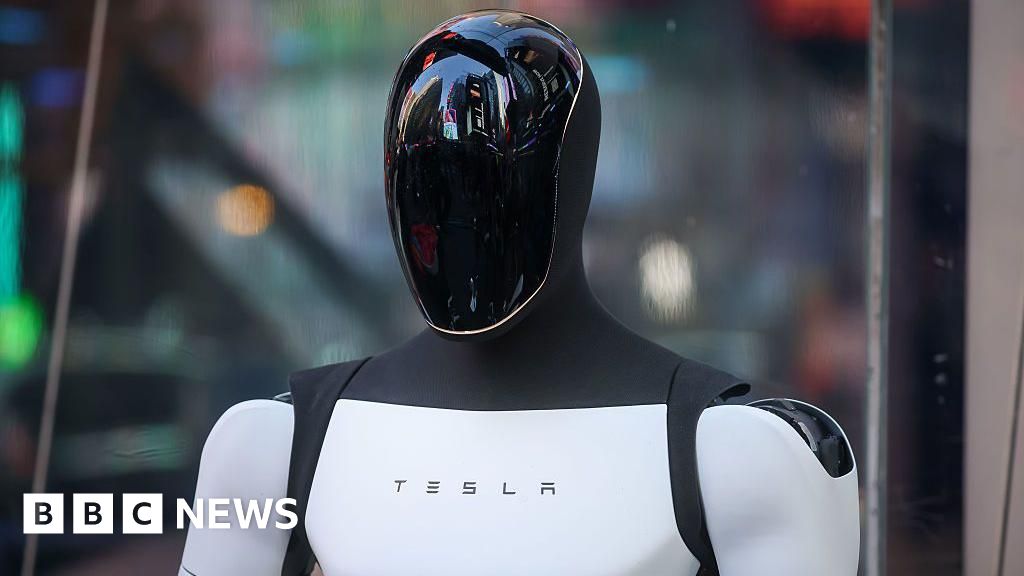Why human-shaped robots loom large in Musk’s Tesla plans


It has appeared in Tesla showrooms, on its factory floors and has even posed with Kim Kardashian.
But Elon Musk’s vision for his human-like robot Optimus is much grander than that.
Since first unveiling it at a Tesla showcase in 2022, the tech billionaire has suggested his company’s droid could play a huge role in the homes and lives of people all over the world.
Along with self-driving robotaxis and Cybertrucks, Musk believes Tesla robots are key to establishing a foothold in the artificial intelligence (AI) landscape.
And investors who signed off on his $1tn pay package on Thursday would appear to agree.
One of the many tasks Musk must complete to get his whopping pay deal is to deliver a million AI bots over the next decade.
But is Tesla’s big bet on humanoid robots rooted in science fiction or reality?
Silicon Valley is gunning hard for humanoids.
A report released by Morgan Stanley on Friday predicted Apple, which is reportedly looking into the robots, could potentially earn $133bn a year from them by 2040.
Foxconn is reported to be deploying them at its Nvidia factory in Texas.
The idea of advanced AI within a human-shaped shell is an astonishingly powerful combination in theory. It would let the tech interact with the physical world around it – and yes that includes us.
While many companies have sought to develop human-like robots for factory and industrial use – such as UK robotics firm Humanoid – some are already looking to insert the tech in homes.
The highly-publicised Neo from tech firm 1X, slated to launch in 2026, can do menial chores like emptying the dishwasher, folding clothes and fetching you items.
It will cost $20,000 but it does come with a caveat – the WSJ reported it was actually controlled by a person wearing a virtual reality headset.
Forrester analyst Brian Hopkins said the falling costs of components, combined with improvements to robot dexterity and AI, was helping to make humanoid robots feasible for a variety of different settings.
“From warehouses and restaurants to elder care and security, new use cases are gaining traction fast,” he wrote in a blog post.
“If current trajectories hold, humanoid robots could disrupt many physical-service industries significantly by 2030.”
Musk has previously told investors his robots had “the potential to be more significant than the vehicle business, over time”.
He’s also said it could give a boost to Tesla’s AI tech overall – particularly in advancing artificial general intelligence (AGI) systems capable of matching human abilities.
“Tesla AI might play a role in AGI, given that it trains against the outside world, especially with the advent of Optimus,” he wrote on X in 2022.
Elsewhere in the space, Boston Dynamics’ hydraulic humanoid Atlas has captivated millions on YouTube with its gymnastics and dance routines.
Viral videos of its leaps, bounds, somersaults and backflips have shown the advances in robotics over the years – with scientists now seizing upon the AI boom to boost their capabilities with systems enabling them to undertake more complex tasks.
When it was retired last year, it was replaced with a newer, fully electric model developers said could contort its metal frame in even more ways.
But many of the roboticists the BBC has spoken to over the years have rolled their eyes about tech firms shaping robots like humans.
Practically, there is little reason for robots to have legs.
The mechanics and hardware involved in creating machine legs are far more intensive.
As one scientist put it – “wheels are so much more efficient”.
And don’t get them started on why a robot doesn’t need to have a head.
Psychologically though, humanoids have long been a human fascination – and something reflected decades of sci-fi.
You need only look to the legacy of characters such as Star Wars’ C-3PO, Futurama’s Bender or the Terminator to see humans might sometimes feel more comfortable around something closely resembling us.
Back in reality, humanoid machines have been often far less polished and more gimmicky, clumsy and buggy than their fictional counterparts.
But that appears to be changing with the likes of Optimus and sleeker droids which edge us closer to living in an uncanny valley.
Tesla’s droid has been appearing in more public settings as of late – serving burgers and popcorn to customers at the company’s Hollywood diner.
Sam Altman, boss of ChatGPT-maker OpenAI, said in May he doesn’t think the world is ready for humanoids, while simultaneously describing it as an incoming moment.
There’s no love lost between him and Elon Musk but on this occasion they seem to be on the same page that the robots are on their way – and Musk certainly has the power, the influence and the cash to make it happen.
